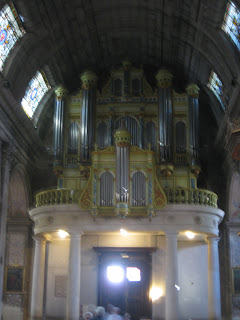 |
| Le Pont d'Avignon |
Avignon is
another old and famous city of Provence, and is probably best known in the U.S.
for the song that high-school French students are required to learn: Sur le pont/d’Avignon/tout le monde/y danse,
danse… (On the bridge at Avignon, everybody dances, dances…) I didn’t
realize until college French that this was some reference to the old Popes who
once held court there. So, yes, there is a fine remnant of a medieval bridge, half collapsed and half intact (a sort of bridge to
nowhere) in Avignon, the actual name of which is Pont Saint-Benezet. More significantly, a huge and marvelously appointed
Palace of the Popes, built during the 13th and 14th centuries, takes up a large part of the old town. We had time to tour the Palais des Papes that first afternoon, and it was clear how materialistic the church and its administrators had become by the Middle Ages, despite efforts by the likes of St. Francis, a century earlier, to bring the church back to Christian simplicity. This ecclesiastical opulence led eventually (after several centuries) to the Reformation, but not until a great deal of blood had been shed in the interest of maintaining economic (and spiritual?) power on the part of the established church.
The church we
visited that morning (Thursday, May 13) in Avignon was the Collegiale
Saint-Agricol, a very ancient church (7th - 15th
centuries). My impression of the organ (a well preserved 19th
century instrument) was that it had a lovely tone with a fantastic emotional
range. I almost wept at one point during the demonstration by the organist.
 |
| Collegiale Saint-Agricol, outside stonework |
 |
| Collegiale Saint-Agricol, organ, nave inside |
Luckily, we had time to tour the Palace of the Popes in Avignon, an amazing structure both outside and in. Another bit of luck was that an annual rose festival was being held there, so we were treated to an abundant, luscious display of virtually every variety imaginable of roses, decorating hallways, growing in gardens, festooning cloisters.
 |
| Palace of the Popes with roses |
From
Avignon, we rode our bus to Saint-Remy de Provence, where we visited the
Collegiale Saint-Martin. The organ there is a new one, installed in 1983. It
was built by the organ builders we had visited previously, Pascal Quoirin, and it was
apparently their first really big organ. It is a huge, powerful instrument,
very versatile in range and sound. The church, itself, is a neo-classical
structure, topped by an odd combination of neo-gothic tower and neo-roman oculus.
 |
| New Quorin organ in the Collegiale Saint-Martin http://www.youtube.com/watch?v=mSZuUYpJk9Y |
We
saw and heard another new organ (Saby & Grenzing) at the Eglise Notre-Dame
in Caumont-sur-Durance. Unfortunately, I don’t have any photos of that church
or organ. I took both stills and movies with my movie camera, which was stolen
later on the trip in Russia. Nonetheless, the organ had a clear, sweet sound in
the upper registers. A Haydn piece had an almost bell-like tone, but a later
Bach fugue sounded a bit muddy. That may have been the playing.
 |
| JAVS sur le Pont d'Avignon; the Rhone flows on beyond |







